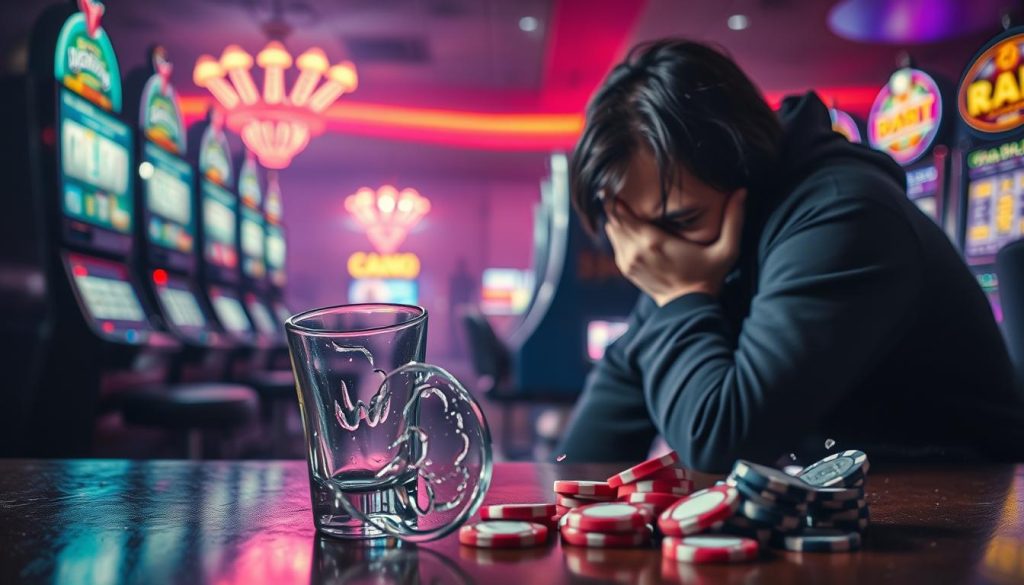I’ve spent years observing behavioral patterns in various contexts. Gambling addiction presents some of the most complex warning signs you’ll encounter. This isn’t about someone who enjoys occasional casino visits or buys lottery tickets.
We’re dealing with a progressive disorder that fundamentally changes thinking, feelings, and behaviors around gambling activities. Through my research and conversations with mental health professionals, I’ve learned something crucial. Early identification can mean the difference between manageable intervention and devastating consequences.
The challenge? Many people don’t recognize the signs until significant damage occurs. This includes those struggling with the addiction themselves. Gambling addiction signs often hide behind seemingly normal behaviors.
This guide walks you through evidence-based indicators that mental health professionals actually use. I’ll combine that with real-world observations that help identify problematic gambling behavior in yourself or others.
Key Takeaways
- Early identification of gambling addiction can prevent devastating consequences
- Warning signs are often complex and hidden behind normal behaviors
- Mental health professionals use specific evidence-based indicators for diagnosis
- Both self-recognition and external observation are crucial for identification
- Gambling addiction is a progressive disorder that changes thinking patterns
- Real-world behavioral observations complement clinical assessment tools
Understanding Gambling Addiction
When I first started researching gambling addiction, I was surprised by how much misinformation exists about this serious mental health condition. Too many people still think it’s simply a matter of poor self-control or moral weakness. The reality is far more complex and scientifically grounded.
Gambling addiction affects brain chemistry in ways similar to substance addictions. It’s not just about making bad choices. The condition involves actual changes in neural pathways that control reward processing and decision-making.
Definition and Overview
The official term is “gambling disorder,” as defined in the DSM-5. This represents a significant shift from earlier classifications. The condition involves persistent and recurrent problematic gambling that causes significant impairment or distress in a person’s life.
What makes compulsive gambling behavior different from occasional gambling? The key lies in the inability to control the urge despite negative consequences. People with gambling disorder continue betting even when they’re losing money they can’t afford to lose.
The brain changes associated with gambling addiction are measurable. Neuroimaging studies show altered activity in areas responsible for impulse control and reward processing. These pathological gambling indicators help clinicians understand why willpower alone isn’t enough to overcome the disorder.
Prevalence in the United States
The numbers are more significant than most people realize. According to the National Council on Problem Gambling, approximately 2-3% of Americans have some form of gambling problem. About 1% meet the criteria for severe gambling disorder.
That translates to roughly 6-8 million adults nationwide. These aren’t just statistics – they represent real people struggling with a legitimate mental health condition.
| Severity Level | Percentage of Population | Estimated Number of Adults | Primary Characteristics |
|---|---|---|---|
| Mild Gambling Problem | 1-2% | 2-4 million | Occasional loss of control, minor financial impact |
| Moderate Gambling Problem | 0.5-1% | 1-2 million | Regular compulsive gambling behavior, relationship strain |
| Severe Gambling Disorder | 1% | 2-3 million | Multiple pathological gambling indicators, significant impairment |
What struck me most during my research is how prevalence varies dramatically by state. States with more gambling opportunities tend to have higher rates of gambling problems. Nevada, for example, has significantly higher rates than states with limited gambling access.
Cultural attitudes also play a role. Areas where gambling is more socially accepted often see higher rates of compulsive gambling behavior. This correlation suggests that environmental factors contribute significantly to the development of gambling disorders.
Key Warning Signs of Gambling Addiction
The most effective way to spot gambling addiction is by examining changes in three key life areas that rarely lie. From my experience working with affected families, gambling disorder warning signs don’t appear as isolated incidents. They develop as interconnected patterns that intensify over time.
What makes identification challenging is how skilled people become at hiding these signs. Especially in early stages, the concealment can be remarkably sophisticated. However, certain indicators consistently emerge across behavioral, financial, and emotional domains.
Behavioral Changes
The first problem gambling symptoms I typically notice involve shifts in daily routines and social interactions. Increased secrecy becomes a hallmark – lying about whereabouts, being vague about time spent away from home, or creating elaborate stories to explain absences.
Excessive preoccupation with gambling activities signals deeper issues. This manifests as constantly thinking about past gambling sessions, planning future bets, or researching gambling strategies online. The person may neglect work responsibilities, family obligations, or personal care.
Social withdrawal often accompanies these changes. Previously social individuals may isolate themselves from friends and family. They might avoid social gatherings where gambling topics could arise or where their absence from normal activities becomes noticeable.
Financial Indicators
Financial gambling disorder warning signs can be more concrete but often remain hidden initially. Unexplained financial losses represent the most obvious red flag. Money disappears from accounts without reasonable explanation, or large withdrawals occur frequently.
Borrowing patterns change dramatically. The person may request loans from family members, friends, or financial institutions more frequently. They might have multiple credit cards maxed out or apply for new credit lines repeatedly.
Selling personal possessions becomes common as gambling debts mount. Valuable items like jewelry, electronics, or collectibles may disappear. Bills may go unpaid while money gets diverted to gambling activities.
Emotional Responses
Emotional indicators of problem gambling symptoms often prove most telling. Extreme mood swings directly correlate with gambling outcomes – euphoria after wins, deep depression after losses. These emotional rollercoasters become more pronounced over time.
Irritability emerges when gambling opportunities are restricted or unavailable. The person may become agitated when unable to access gambling venues or when questioned about their activities. Anxiety and restlessness increase during periods away from gambling.
The phenomenon I call “chasing losses” represents perhaps the most dangerous emotional response. This desperate need to win back lost money drives increasingly risky behavior. The person becomes convinced that the next bet will solve their financial problems, leading to deeper losses and more desperate attempts to recover.
Depression and anxiety intensify when not gambling, creating a cycle where gambling becomes the primary coping mechanism. This emotional dependence makes breaking the pattern particularly challenging without professional intervention.
Common Myths About Gambling Addiction
The myths surrounding gambling addiction are not just wrong – they’re genuinely dangerous. I’ve watched these misconceptions prevent countless people from recognizing their own problems or seeking help. These false beliefs create barriers that keep individuals trapped in cycles of excessive gambling habits while their families suffer in silence.
What makes these myths particularly harmful is how they shape public perception. Society tends to view gambling problems through a lens of moral judgment rather than medical understanding. This perspective damages recovery efforts before they even begin.
Myth vs. Reality
Let me address the most persistent myths I encounter. Myth number one: “Gambling addicts gamble every day.” The reality? Many people with gambling disorders experience periods of complete abstinence followed by intense gambling binges. This pattern actually makes the problem harder to recognize.
Myth number two: “It only affects people with addictive personalities.” This couldn’t be further from the truth. Gambling addiction can develop in anyone, regardless of their history with other substances or behaviors. I’ve seen it affect successful professionals, devoted parents, and people with no prior addiction history.
Another dangerous myth suggests that people can simply “stop if they really wanted to.” This ignores the neurological changes that occur with gambling disorders. The brain’s reward system becomes hijacked, making willpower alone insufficient for recovery.
Gambling addiction risk factors include early exposure to gambling, mental health conditions like depression or anxiety, substance abuse history, and personality traits such as impulsivity or competitiveness. However, having these risk factors doesn’t guarantee someone will develop a problem.
The Impact of Stigma
The stigma surrounding gambling addiction creates devastating consequences. Only about 8% of people with gambling disorders ever receive treatment. Think about that statistic – it means 92% of affected individuals never get professional help.
This shame keeps people isolated, which actually worsens their condition. Family members often enable the behavior by covering debts or making excuses. The secrecy becomes a prison that traps everyone involved.
I’ve observed how stigma manifests in everyday conversations. People joke about “gambling problems” without understanding the serious medical condition behind it. This casual treatment minimizes the real suffering experienced by millions of Americans.
The shame also prevents open discussions about prevention. When we treat gambling addiction as a moral failing rather than a health condition, we miss opportunities for early intervention. Education and awareness become nearly impossible when stigma dominates the conversation.
Breaking through these myths requires changing how we talk about gambling disorders. We need to approach them with the same compassion and medical understanding we show other addictions. Only then can we create an environment where people feel safe seeking help.
Statistics on Gambling Addiction
When I first started researching gambling addiction statistics, I was struck by how the data tells such a compelling human story. These aren’t just abstract numbers floating around in research papers. They represent real people struggling with a serious condition that affects millions of Americans every year.
The scope of this problem becomes clear when you look at the national picture. We’re dealing with something that touches nearly every community across the country. The patterns that emerge from this data help us understand where gambling addiction treatment resources are needed most.
National and State-Level Data
The national statistics paint a sobering picture of gambling addiction’s reach. About 2.6% of American adults experience a gambling problem in any given year. That translates to roughly 6.5 million people currently struggling with this addiction.
The lifetime prevalence tells an even more concerning story. Research shows that 5.3% of adults will develop a gambling problem at some point in their lives. This means over 13 million Americans will face this challenge during their lifetime.
State-by-state variations reveal fascinating patterns. Nevada leads with the highest rates of problem gambling, which makes sense given the state’s gambling-centric economy. Louisiana follows closely behind, while states like Utah and Hawaii show the lowest rates. Utah’s low numbers reflect their strict gambling prohibitions, while Hawaii’s isolated geography limits gambling opportunities.
These regional differences highlight where gambling addiction support services need the most funding and attention. States with higher rates often struggle to provide adequate treatment resources for their populations.
Demographics Most Affected
The demographic breakdown reveals some surprising patterns that challenge common assumptions. Men develop gambling problems at higher rates than women overall. However, women who do develop gambling issues progress from casual gambling to problem gambling much faster.
Researchers call this rapid progression “telescoping.” Women can go from occasional gambling to serious addiction in a matter of months rather than years. This pattern has major implications for early intervention strategies.
Age demographics show that young adults between 18-29 have the highest rates of problem gambling. But older adults who develop gambling problems face more severe consequences. Their fixed incomes and retirement savings create higher stakes for financial losses.
Certain populations face disproportionate risks. Veterans show elevated rates of gambling addiction, often linked to trauma and mental health challenges. People with existing mental health conditions are also at higher risk. Lower socioeconomic groups face additional vulnerabilities due to limited resources for recovery.
| Demographic Group | Problem Gambling Rate | Key Risk Factors | Treatment Challenges |
|---|---|---|---|
| Men (18-65) | 3.2% | Higher risk-taking behavior | Reluctance to seek help |
| Women (18-65) | 2.1% | Rapid progression pattern | Social stigma concerns |
| Young Adults (18-29) | 4.1% | Online gambling access | Limited financial resources |
| Veterans | 5.8% | PTSD and trauma | Geographic access barriers |
| Lower Income Groups | 3.7% | Financial stress | Insurance limitations |
These statistics underscore the urgent need for targeted intervention strategies. Understanding who’s most at risk helps us develop better prevention programs and allocate treatment resources more effectively. The data shows that gambling addiction doesn’t discriminate, but certain groups need specialized approaches to recovery.
The Psychology Behind Gambling Addiction
The brain’s response to gambling creates a psychological trap that makes recognizing addiction symptoms particularly difficult. When I’ve worked with individuals struggling with gambling problems, I’ve noticed how the addiction hijacks the brain’s reward system in ways that mirror substance dependencies. This neurological rewiring explains why learning how to spot a gambling addiction requires understanding the underlying psychological mechanisms.
The dopamine release doesn’t just happen when someone wins. It occurs in anticipation of potentially winning, creating a powerful cycle that becomes increasingly difficult to break. Over time, the brain demands more stimulation to achieve the same dopamine response, which is why people gradually increase their betting amounts or frequency.
“About 75% of people with gambling disorders also have another mental health condition – most commonly mood disorders, anxiety disorders, or substance use disorders.”
Risk Factors
Several key risk factors make certain individuals more vulnerable to developing gambling problems. Genetic predisposition plays a significant role – gambling problems often run in families, suggesting both inherited traits and learned behaviors contribute to addiction development.
Early exposure to gambling significantly increases risk. People who start gambling before age 18 are more likely to develop problems later in life. Trauma history also creates vulnerability, as gambling can become a coping mechanism for unresolved emotional pain.
The most complex aspect I’ve observed is the high rate of comorbidity. This overlap makes identifying gambling addiction signs more challenging because symptoms can mask each other or appear as something else entirely.
The Role of Impulsivity
Impulsivity in gambling addiction goes beyond general impulsive behavior. Research reveals that people with gambling problems struggle with what psychologists call “delay discounting” – they heavily favor immediate rewards over larger future benefits.
This psychological pattern explains why traditional advice like “just stop gambling” doesn’t work. The brain has been rewired to prioritize immediate gratification over long-term consequences. Understanding this helps explain why spotting gambling addiction requires looking beyond surface-level behaviors.
The impulsivity factor also affects decision-making in other life areas. People may make poor financial choices, struggle with relationships, or have difficulty maintaining employment – all of which can serve as indirect indicators when trying to identify gambling problems.
What makes this particularly challenging is that impulsivity symptoms can fluctuate. Someone might appear completely in control most of the time, then make dramatically poor decisions when triggered by specific situations or emotional states.
How Gambling Addiction Affects Relationships
I’ve witnessed firsthand how gambling addiction transforms loving families into battlegrounds of mistrust and financial chaos. The ripple effects extend far beyond the individual struggling with compulsive gambling behavior. Every relationship becomes a casualty in this battle.
What strikes me most is how quickly trust erodes. Partners who once shared everything suddenly find themselves living with secrets and lies. The person with the gambling problem starts creating elaborate stories to explain missing money or unexplained absences.
Children often bear the heaviest burden. They sense the tension but don’t understand why mom and dad argue about money constantly. The emotional neglect that follows can create lasting psychological wounds that extend well into adulthood.
Family Dynamics
Family life becomes unpredictable when gambling addiction enters the picture. I’ve observed how problem gambling symptoms manifest differently within family structures. Spouses report feeling like they’re married to a stranger.
The financial strain creates immediate stress. Bills go unpaid while money disappears into gambling venues. Families lose homes, cars, and savings accounts. The person gambling often promises to stop, creating a cycle of hope and disappointment.
Trust becomes the biggest casualty. Every conversation feels loaded with potential deception. Family members start checking bank accounts, hiding money, and questioning every explanation. This constant vigilance exhausts everyone involved.
Children develop their own coping mechanisms. Some become overly responsible, trying to fix the family’s problems. Others act out, seeking attention in negative ways. Many carry guilt, believing they somehow caused the family’s troubles.
The enabling pattern often develops unconsciously. Family members cover debts, make excuses to employers, or lie to extended family about the situation. While well-intentioned, these actions prevent the gambling addict from experiencing natural consequences.
Friendships and Social Life
Social relationships suffer dramatically when gambling takes priority. Friends notice the changes first – cancelled plans, borrowed money, and increasingly distant behavior. The person with compulsive gambling behavior starts avoiding social situations where gambling isn’t possible.
Money becomes a wedge between friends. Borrowing starts small but escalates quickly. Friends who lend money rarely see it returned. This creates resentment and damages long-standing relationships.
Social isolation becomes both a symptom and a trigger. The person withdraws from activities they once enjoyed. They skip family gatherings, miss work events, and abandon hobbies. This isolation then drives them back to gambling for companionship and excitement.
The gambling environment becomes their primary social outlet. They develop relationships with other gamblers, dealers, or online gambling communities. These relationships often revolve entirely around gambling activities.
Friends and family members often don’t know how to help. They may try interventions, ultimatums, or emotional appeals. When these efforts fail, many people distance themselves to protect their own well-being.
The social stigma surrounding gambling addiction makes recovery more challenging. Unlike other addictions, gambling problems often remain hidden longer. This secrecy prevents early intervention and support.
Recovery requires rebuilding damaged relationships slowly. Trust must be earned back through consistent actions over time. Many relationships don’t survive the damage, but those that do often become stronger than before.
Tools for Self-Assessment
Recognizing gambling problems early requires honest self-evaluation and the right assessment tools. I’ve seen too many people struggle because they waited until their situation became desperate before seeking help. The good news is that several reliable screening instruments can help identify pathological gambling indicators before they spiral out of control.
These self-assessment tools aren’t meant to replace professional diagnosis. Think of them as your first checkpoint – a way to gauge whether your gambling habits warrant closer attention. The key is approaching them with complete honesty, even when the questions make you uncomfortable.
Online Quizzes and Tests
The Problem Gambling Severity Index (PGSI) stands out as the most widely used screening tool today. It asks nine specific questions about your gambling behavior over the past 12 months. I appreciate its straightforward approach – no confusing jargon or trick questions.
The PGSI covers essential areas like betting more than you can afford, feeling guilty about gambling, and whether gambling has caused health problems. Each question uses a four-point scale from “never” to “almost always.” Your total score places you in one of four categories: non-problem gambling, low-risk, moderate-risk, or problem gambling.
Another option is the South Oaks Gambling Screen (SOGS), though I find it less accurate for identifying mild problems. It’s better suited for detecting severe gambling disorders. The SOGS asks 20 questions about gambling behavior, debts, and family reactions.
For a quick initial assessment, I always recommend the “20 Questions” from Gamblers Anonymous. It’s been around for decades and covers the most common gambling disorder warning signs. Questions like “Do you gamble to escape worry or trouble?” and “Have you ever committed an illegal act to finance gambling?” cut straight to the heart of problem gambling.
| Assessment Tool | Number of Questions | Time to Complete | Best For |
|---|---|---|---|
| Problem Gambling Severity Index (PGSI) | 9 questions | 5-10 minutes | All severity levels |
| South Oaks Gambling Screen (SOGS) | 20 questions | 10-15 minutes | Severe gambling problems |
| Gamblers Anonymous “20 Questions” | 20 questions | 10-15 minutes | Initial screening |
| National Council Problem Gambling Quiz | 10 questions | 5-10 minutes | General awareness |
The National Council on Problem Gambling offers online versions of these assessments on their website. They’re free, confidential, and available 24/7. I’ve found their interface user-friendly, even for people who aren’t tech-savvy.
One important tip: consider having a trusted friend or family member review your answers if you’re comfortable with that. We often minimize our own behavior or rationalize problematic patterns. An outside perspective can provide valuable insight into your responses.
Professional Resources
While self-assessment tools provide valuable insights, professional evaluation offers deeper analysis of pathological gambling indicators. Licensed therapists who specialize in gambling disorders bring expertise that online quizzes simply can’t match.
Certified gambling counselors receive specific training in addiction treatment and understand the unique challenges of gambling disorders. They can conduct comprehensive assessments that consider your personal history, family dynamics, and co-occurring mental health conditions.
Psychiatrists play a crucial role when gambling problems coincide with depression, anxiety, or other mental health issues. I’ve seen cases where treating underlying conditions significantly improved gambling behavior outcomes.
Most states operate problem gambling helplines that provide free, confidential assessments and referrals. These services connect you with local resources and can schedule appointments with qualified professionals. The counselors manning these lines understand gambling addiction and won’t judge your situation.
Many employee assistance programs (EAPs) also offer gambling addiction resources. Check with your HR department – you might have access to free counseling sessions or assessment services through your workplace benefits.
Remember, these screening tools identify potential problems – they don’t provide definitive diagnoses. A positive screen should prompt you to seek professional evaluation, not serve as your final answer. The goal is early identification and intervention, giving you the best chance for successful recovery.
The most important factor in any assessment is honesty. It’s easy to minimize gambling frequency or downplay financial losses when taking these tests. But accurate results require truthful answers, even when they’re uncomfortable to acknowledge.
Seeking Help: Treatment Options
Treatment options for gambling addiction have evolved dramatically over the past decade. I’ve witnessed firsthand how the right combination of professional support can help people break free from excessive gambling habits and rebuild their lives. The key lies in understanding that recovery isn’t a one-size-fits-all process.
What strikes me most about modern treatment approaches is their focus on addressing the underlying gambling addiction risk factors rather than just the symptoms. This shift has made recovery more sustainable and effective for many people I’ve worked with over the years.
Therapy and Counseling
Cognitive-behavioral therapy stands as the gold standard for treating gambling disorders. I’ve seen CBT help countless individuals identify their triggers and develop healthier coping strategies. The therapy works by changing thought patterns that lead to gambling urges.
During CBT sessions, people learn to recognize distorted thinking patterns. They might believe they’re “due for a win” or that they can control random outcomes. These cognitive distortions fuel excessive gambling habits and need professional intervention to address effectively.
Motivational interviewing offers another powerful approach, especially for those who feel ambivalent about change. This technique helps people explore their own motivations for recovery. I find it particularly effective with clients who aren’t ready to commit to complete abstinence yet.
Individual therapy sessions provide a safe space to explore personal gambling addiction risk factors. These might include childhood trauma, depression, or anxiety disorders that contribute to addictive behaviors. Many therapists now specialize specifically in gambling disorders, understanding the unique shame and challenges involved.
Support Groups
Gamblers Anonymous follows the proven 12-step model that’s helped millions overcome various addictions. The peer support aspect cannot be overstated – hearing from others who’ve walked the same path provides hope and practical strategies. Meetings are available both in-person and online across the country.
Gam-Anon serves family members and friends affected by someone else’s gambling problem. I always recommend this resource to loved ones because gambling addiction impacts entire family systems. The support helps them understand they’re not alone in their struggles.
SMART Recovery takes a more scientific, self-management approach compared to traditional 12-step programs. It focuses on building motivation, coping with urges, managing thoughts and behaviors, and living a balanced life. Some people prefer this evidence-based methodology over spiritual approaches.
The regulatory landscape continues evolving, which affects how treatment resources are funded and accessed. This makes staying informed about available options even more important for those seeking help.
| Treatment Type | Duration | Success Rate | Best For |
|---|---|---|---|
| Cognitive Behavioral Therapy | 12-20 sessions | 60-80% | Identifying triggers and changing thought patterns |
| Gamblers Anonymous | Ongoing | 40-60% | Peer support and spiritual approach |
| SMART Recovery | Ongoing | 45-65% | Self-management and evidence-based methods |
| Residential Treatment | 30-90 days | 70-85% | Severe cases requiring intensive intervention |
Residential treatment programs exist for severe cases, though they’re less common than for substance addictions. These intensive programs provide 24/7 support and remove people from gambling environments entirely. They’re particularly effective for those with co-occurring mental health conditions.
Many people benefit from combining multiple treatment approaches. Individual therapy paired with group support often produces the best outcomes. Some also need medication for underlying depression or anxiety that contributes to their gambling behaviors.
The most important factor in successful treatment is finding the right combination that matches each person’s specific needs and circumstances. Recovery is absolutely possible with proper support and commitment to the process.
Relapse Prevention Strategies
Maintaining sobriety from gambling demands more than willpower – it requires a comprehensive relapse prevention strategy. I’ve observed that the first year after gambling addiction treatment presents the highest risk for setbacks. The statistics are sobering, but they don’t have to define your journey.
Recovery isn’t a destination you reach once and forget about. It’s an ongoing process that requires daily attention and strategic planning. Think of it like maintaining physical fitness – you can’t work out once and expect to stay in shape forever.
Developing Healthy Coping Mechanisms
The foundation of preventing gambling relapse starts with understanding your personal triggers. Stress tops the list for most people, but I’ve learned that triggers can be surprisingly diverse. Boredom, depression, relationship conflicts, and even positive emotions like excitement can spark gambling urges.
What works for one person might not work for another. Some people find relief through physical exercise – running, weightlifting, or even walking can redirect that restless energy. Others discover creative outlets like painting, writing, or music provide the mental stimulation they once sought through gambling.
Financial management becomes a critical component of your coping strategy. This might mean having a trusted family member handle your finances temporarily. It could involve installing blocking software on your devices or avoiding specific locations where gambling occurs.
The most successful recovery happens when you have multiple strategies in your toolkit, because what works in one situation might not work in another.
Meditation and mindfulness practices have proven particularly effective for many people. These techniques help you recognize urges without immediately acting on them. The goal isn’t to eliminate gambling thoughts entirely – that’s unrealistic. Instead, you learn to observe these thoughts without letting them control your actions.
| Trigger Type | Healthy Coping Strategy | Implementation Time | Effectiveness Rating |
|---|---|---|---|
| Stress | Deep breathing exercises | 5-10 minutes | High |
| Boredom | Structured activities | 30-60 minutes | Medium-High |
| Depression | Professional counseling | Ongoing | High |
| Social pressure | Exit strategies | Immediate | Medium |
Building a Support Network
Gambling addiction support extends far beyond your immediate family and friends. Your network should include healthcare providers, support group members, sponsors, and sometimes even understanding employers. Each person serves a different role in your recovery journey.
An accountability partner can be invaluable – someone you can call when experiencing gambling urges. This person needs to be available, understanding, and committed to your recovery. They’re not there to judge you, but to provide immediate support when you need it most.
Technology plays a dual role in modern recovery. While online gambling presents new risks, recovery apps can provide 24/7 support and tracking tools. Some apps block gambling sites automatically, while others offer meditation guides or connect you with support communities.
Support groups offer something unique that individual therapy cannot – the shared experience of others who truly understand your struggle. Whether it’s Gamblers Anonymous, SMART Recovery, or online communities, these groups provide both accountability and hope.
Your recovery toolkit should be comprehensive and easily accessible. Include emergency contact numbers, coping strategies that work for you, and reminders of why you chose recovery. Some people carry physical cards with this information, while others use smartphone apps.
Remember that building a support network takes time. Start with one or two trusted individuals and gradually expand your circle. Quality matters more than quantity – a few committed supporters are more valuable than many casual acquaintances.
The most successful people in recovery have learned to view their support network as essential infrastructure, not optional assistance. They maintain these relationships actively, contributing to others’ recovery journeys while strengthening their own foundation for long-term success.
Predictions for Future Trends in Gambling Addiction
The gambling landscape is evolving at breakneck speed, and I’m seeing patterns that suggest we’re heading toward some major shifts in how gambling addiction manifests. The next few years will bring challenges we’ve never faced before, but also tools that could revolutionize how we identify and treat problem gambling.
What worries me most is how accessible gambling has become. We’re not just talking about casinos anymore. Sports betting apps are in everyone’s pocket, and the normalization of gambling through advertising is creating new populations of at-risk individuals.
Technological Advances in Gambling
The tech side of gambling is where I see the biggest changes coming. Virtual reality gambling is already being tested, and it’s going to create experiences so immersive that traditional gambling addiction signs might not apply anymore. When someone can feel like they’re actually in Monte Carlo while sitting in their living room, the psychological impact becomes much more intense.
Mobile betting platforms are getting smarter too. They’re using AI to track betting patterns and spending habits in real-time. This technology can spot problem gambling behaviors faster than ever before, but it also means gambling companies have unprecedented access to user data.
Here’s what I find promising though – the same technology creating these risks is also developing solutions. AI-powered monitoring systems can identify gambling addiction signs within hours of problematic behavior starting. Digital therapeutics apps are being designed specifically for gambling addiction treatment, offering 24/7 support that wasn’t possible before.
Regulatory Changes
The regulatory landscape is shifting rapidly, and I’m seeing some encouraging trends. More states are implementing mandatory spending limits and requiring gambling operators to fund treatment programs. This isn’t just good policy – it’s creating a standardized approach to How to Spot a Gambling Addiction across different jurisdictions.
What’s particularly interesting is how regulators are starting to hold gambling companies accountable for identifying problem gamblers. The days of “buyer beware” are ending, and operators are being required to implement sophisticated harm reduction measures.
Federal oversight is also increasing. I expect we’ll see national standards for problem gambling prevention within the next five years. This means better funding for research, more consistent treatment options, and improved training for healthcare providers to recognize gambling addiction signs.
The challenge will be balancing personal freedom with public health protection. Technology gives us powerful tools for both enabling and preventing gambling addiction, and how we choose to use these tools will determine whether the future trends help or harm vulnerable populations.
Frequently Asked Questions about Gambling Addiction
These questions come up repeatedly in my conversations with people concerned about their gambling habits. The answers deserve honest, straightforward responses that can guide your next steps.
How do I know if I have a problem?
If you’re asking this question, it’s worth taking seriously. Key signs of compulsive gambling behavior include betting money you can’t afford to lose, lying about gambling activities, and feeling restless when not gambling. You might find yourself chasing losses or gambling to escape negative emotions.
The frequency matters less than the impact. If gambling is causing problems in your relationships, work, or finances, that’s a significant red flag. Trust your instincts about your own behavior patterns.
What resources are available for help?
More resources exist than most people realize. The National Problem Gambling Helpline (1-800-522-4700) provides 24/7 support and referrals. Most states have problem gambling councils with local resources.
Recognizing pathological gambling indicators early opens doors to effective treatment. Many health insurance plans cover gambling addiction treatment. Free support groups like Gamblers Anonymous meet in most communities and online. For family members, Gam-Anon provides support and education.
Remember that gambling addiction is treatable. Seeking help demonstrates strength, not weakness.










